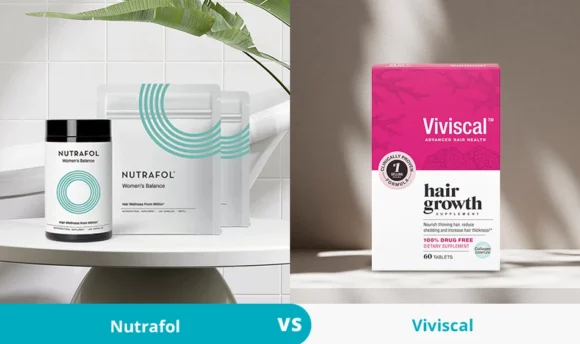Best Way to Dry Hair: Tips and Tricks for Healthy Locks
How you dry your hair affects how it looks. Learn the best ways to dry your hair and achieve long, strong, and beautiful locks.

If you’ve found a shampoo that your hair loves and mastered the art of shopping for the best conditioner, treatment, and hair styling products, you may believe your wash days are well taken care of. But what happens when you finish showering?
Do you cover your hair with a microfiber towel? Do you give your locks a decent rub?
Drying your hair is fundamental – how you do it can cause breakage, frizz, and other issues.
Explore different ways to dry your hair, including such techniques as a towel or T-shirt drying, blow drying, or using a diffuser to keep your locks looking healthy.
What’s the Best Way to Dry Hair?
The best way to dry hair is to use a microfiber towel or a clean cotton T-shirt. Microfiber towels and T-shirts are gentle and soft and can benefit all hair types. They are more unlikely to snag, tear, or shred your hair than a standard towel.
Towel drying also eliminates the need to expose your hair to heat. It can help decrease frizz and keep curls in place if you don’t rub your hair too hard.
While air drying is the most popular method to dry hair, recent studies suggest that naturally drying your hair is not the best way.
Researchers found that staying in contact with water for prolonged periods damages the hair’s cell membrane and causes it to swell. When the cell membrane complex layer swells, the hair weakens with time.
Prolonged water stays in your hair and damages your hair slowly by breaking down the natural proteins in your strands. It weakens the strength of your locks and the scalp, resulting in hair loss.
If you wash your hair more often, the consistent swelling and deswelling of the hair can speed up hair-thinning, increasing breakage. If you have fine hair, it will stretch and seem limp. Your strands will be more frizzy if you have textured or curly hair. And if you have very thick hair, the damp environment can draw in bacteria and fungus, causing scalp issues.
The above study noted that blow-drying hair could be healthier than air-drying, which is possible using medium to low heat settings.
Different hair types require different drying methods. For example, people with wavy, fine, thin, straight, dyed, or curly hair may benefit from air drying. However, you should pat your damp hair with a towel before letting it air dry.
If you have thick, kinky, coarse, or relaxed hair, you may want to use a hair dryer but ensure you use a protective product before you begin. This will keep your hair from drying out.
What Should You Use to Dry Your Hair?
When it comes to drying your hair, there are different options involved. You can use a microfiber towel, T-shirt, blow dryer, or diffuser, or let it dry naturally.
Microfiber towels or T-shirts can be a good choice. They absorb water much faster than a normal towel, reducing the need for rigorous towel drying and preventing breaking. The microfiber towel and T-shirt are a gentler method of drying your hair that will leave it frizz-free!
When used correctly, a blow dryer can help you dry your hair faster and achieve your desired hairstyle while maintaining healthier strands.
Look for a higher-wattage blow dryer. Experts recommend using 1,800 or higher if you have fine hair. Many commercial blow dryers have a wattage of 3,600 or higher. While these are pricey, they are ideal for thick and curly hair. They will cut drying time in half and do less harm.
A diffuser is a blow dryer attachment that distributes air to prevent frizz and interference with the natural wave pattern. It serves any hair texture, from wavy to corkscrew curls.
If you don’t want to use a hair dryer, let your hair air dry. This entails allowing air to circulate freely through your hair while drying it.
This can be accomplished by patting your wet hair with a towel to remove excess water and then allowing it to air dry.
How to Dry Your Hair Without Damaging It? A Complete Guide
Drying your hair can be a challenging task, especially if you want to avoid damaging your strands. Here are some tips for drying your hair and keeping it strong.
#1 How to dry hair properly with a towel
Choose a soft towel rather than a coarse, nubby towel when towel drying your hair. This will keep your hair from being tangled and damaged. A soft towel causes hair cuticles to lay flat, allowing hair to dry in lovely, glossy curls.
While still in the shower and your hair is dripping, run your hands through it and gently squeeze out the excess water. It’s easier to towel dry your hair when water isn’t running out. Don’t twist your hair because it can easily get damaged.
Get your towel and gently blot and squeeze your hair in portions, going from the roots to the tips until your hair is fully towel-dried. Avoid wringing out your hair, squeezing it too hard, or rubbing it with a towel, as this will roughen your cuticles, tangle, and break your strands. Simply use the towel to gently absorb the water.
Follow by applying a leave-in-conditioner and gently detangle with a wide-toothed comb or your fingers starting at the ends and going up to your roots.
#2 How to blow dry your hair correctly
Blow-drying your hair right after getting out of the shower will harm your mane. Instead, use a microfiber towel to dry your wet hair, as described above.
Apply heat-protectant products, including leave-in conditioners and detangling mists from the mids to the end. Hair styling tools such as blow dryers and curling irons can harm your hair if not protected with heat-protectant products.
While these lotions and sprays won’t stop all the damage, they will help slow it down.
Using a cooler setting on your hair dryer is the easiest way to limit the heat that reaches your hair. You can fully dry your hair even if your blow-dryer is on low or medium heat.
One study cautioned that heat settings above 284ºF cause irreparable damage to the cuticles. Expect completely damaged hair at high temperatures of 392ºF.
#3 How to dry your hair with a T-shirt
Like microfiber towels for hair, cotton T-shirts are soft and don’t snag on the strands or cause damage. The fibers in cotton T-shirts are also closely knitted, so they absorb water on your hair without over-drying.
Gently squeeze the extra water out of your hair with a clean cotton T-shirt. Avoid wringing or excessively rubbing the strands. The tee will absorb excess water while preventing frizz. T-shirts lack rough grooves, so the flat surface allows water to sink in and slide over the hair rather than roughing it up.
Place your head in the cotton T-shirt opening and press your hair to absorb water. Twist and wrap the cotton T-shirt over your head, tucking the front opening of your hairline in.
Wrap the T-shirt for 10–15 minutes if you have fine hair. If you have thick, curly hair, cover it for 20–25 minutes.
#4 How to use a diffuser for drying your hair?
You can use a hair diffuser to dry your hair and enhance curls and waves without making it frizzy. Diffusers are fitted at the end of hair dryers to protect your hair from direct heat, decreasing hair damage and leaving your hair texture intact.
Wrap your hair in a T-shirt or a microfiber towel and pat your wet hair, then apply a leave conditioner to moisten your hair and prevent frizz. If you have wavy hair, you may want to skip the leave-in conditioner. This is because it can weigh down your hair, reducing the curls and volume you’d want to create with a hair diffuser.
Before using the diffuser, we recommend applying a heat protectant to your hair to provide a barrier between the heat and your hair. This will help protect your hair from heat damage.
Heat protectants have components such as humectants, which retain moisture and prevent frizz; amino acids, such as keratin, which strengthen hair while providing antioxidants; and natural oils and extracts, such as aloe, which seal the hair’s cuticle.
Lift a portion of your hair into the diffuser, then turn your dryer to low – too much heat and airflow will destroy your curls and make them look frizzy.
Begin by drying the ends of your hair and working your way up to the roots. You can also turn your head upside down to add volume to the roots and dry hard-to-reach areas like the back and middle of your head.
How Can You Make Your Hair Dry Faster?
After showering, wrap your hair in a microfiber towel or a T-shirt. Leave your hair in while you get ready – eat breakfast or do other things. Check back in 10–15 minutes, and your hair should be halfway dry.
Apply a leave-in conditioner and comb through with a wide-tooth comb. Conditioner not only smoothes your hair but can also help it dry faster. This is because conditioners and leave-in products reduce interfiber friction, making it simpler to comb hair and thus creating air circulation.
If you don’t want to use a hair dryer, you can let your hair air dry as you comb or run your fingers after every 10–15 minutes. The time it takes to dry will depend on how much water you remove, the weather, and the thickness of your hair.
If you’re using a hair dryer, start with rough drying. This means blow-drying your hair with only your fingers, tousling it, and concentrating on the roots. Then go from there – drying the roots will usually assist in drying the ends.
FAQs
Shaking your head for a few minutes after showering will help your hair dry faster. You can then use your fingers to lift the roots. This is to speed up the drying process before covering it with a microfiber towel or T-shirt.
Pat excess water from your hair with a microfiber towel or T-shirt, then comb it through with a wide-tooth comb to promote air circulation. Let it air dry as you continue with your morning routine.
The healthiest method to dry your hair is to pay excess moisture out with a microfiber towel or a T-shirt before blow drying. Let it dry 70–80% of the way before blow drying on low to medium heat.
Drying your hair naturally can be a great way to give your mane a break from the heat. However, if your hair stays damp for a long time, say 2 hours, it can cause your hair’s cuticle to swell, causing breakage.
If you have long, curly, or thick hair that retains moisture longer, tie it into a turban and let the microfiber towel absorb the extra water for 10–15 minutes. You can let it air dry or use a diffuser if it’s naturally curly or wavy. You can blow dry it if it’s straight, but use a cooler setting to dry it slowly.
A Word From a Trichologist
Wet hair needs more attention due to structural changes. When exposed to water, the hair shafts absorb and swell, making it more prone to damage. That’s why you should handle your just-showered strands more gently to maintain the health of your hair.
Putting in a ponytail after shampooing or swimming can be tempting, but that’s a no-no. The hair is elastic and fragile. When you tie it back, it stretches a third of its length leading to breakage.
Avoid brushing your hair when it’s wet. This is because wet hair is weak and can be prone to breakage, damage, and split ends. You can also remove hair from the roots this way. Wait until it’s almost or completely dry. If you have tangles, you can use a wide-tooth comb to restore order, but ensure the tooth ends are smooth, so you don’t irritate your scalp.
If your hair is soaking wet, wait until it’s slightly dryer before applying style products so they can reach the hair shaft. Hair absorbs more effectively when it is slightly dry.
And don’t sleep with damp hair – again, it will result in tangles, breaking, and stretching your hair.
Conclusion
Knowing how to wash and dry your hair correctly will result in healthier-looking locks. Once you’ve perfected your washing technique, use the correct towel and drying method. Your hair will maintain more moisture and respond well to styling. It will also seem and feel less frizzy.
There are various methods for drying or speeding up the drying process, including using a microfiber towel or cotton T-shirt, blow drying, diffusing, and air drying. And while each of these methods is effective on its own, you may combine them for even faster-drying locks.

















































 Select your language:
Select your language: 








